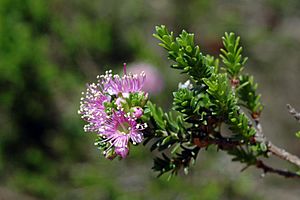Kunzea ciliata facts for kids
Quick facts for kids Kunzea ciliata |
|
|---|---|
 |
|
| Scientific classification | |
| Genus: |
Kunzea
|
| Species: |
ciliata
|
Kunzea ciliata is a beautiful flowering plant. It belongs to the myrtle family, called Myrtaceae. This plant is special because it only grows in the south-west part of Western Australia. It's a bushy plant that spreads out. It usually grows to be about 0.8 to 1.5 meters (2.6 to 4.9 feet) tall. You can see its pretty pink flowers bloom in October and November.
Contents
About the Kunzea ciliata Plant
The Kunzea ciliata is a spreading shrub. It usually grows between 0.8 and 1.5 meters (about 3 to 5 feet) tall. When its branches are young, they are very hairy. As they get older, they become smooth. The plant then grows a corky bark.
Leaves and Flowers
The leaves of this plant are narrow. They are shaped like an ellipse or a spear. The narrower end points towards the base. Most leaves are about 4 to 5 millimeters (0.16 to 0.20 inches) long. They are also about 1.5 millimeters (0.06 inches) wide. Each leaf has a short stem called a petiole, which is up to 0.5 millimeters (0.02 inches) long.
The flowers are pink or pale pink. They grow in round groups of twelve to eighteen flowers. These groups are usually found near the ends of the longer branches. The branches keep growing even after the flowers bloom.
Flower Parts
The plant has leaf-like parts called bracts. They are about 2 to 3 millimeters (0.08 to 0.12 inches) long. These bracts are more or less hairy. There are also smaller bracteoles in pairs at the base of each flower.
The bottom part of the flower, called the floral cup, is 3 to 4 millimeters (0.12 to 0.16 inches) long. It is smooth. The sepals are triangular and about 1 millimeter (0.04 inches) long. The petals are broadly egg-shaped or almost round. They are about 3 millimeters (0.12 inches) long.
Each flower has many stamens, which are the parts that make pollen. There are 43 to 48 stamens in several rows. Each stamen is about 3.5 to 5 millimeters (0.14 to 0.20 inches) long.
Flowering Time and Fruit
This plant usually flowers in October and November. Sometimes, it can bloom in other months if the weather is good. After flowering, the plant produces a fruit. This fruit is an urn-shaped capsule. It still has the remains of the sepals attached to it.
Naming the Kunzea ciliata
The Kunzea ciliata was first officially described in 1996. A scientist named Hellmut Toelken gave it its formal description. He published his findings in the Journal of the Adelaide Botanic Garden.
The second part of its name, ciliata, comes from a Latin word. The word is cilium, which means "eyelash." This name was chosen because the plant has hairy bracts, which look a bit like eyelashes.
Where Kunzea ciliata Lives
You can often find K. ciliata growing on or near granite slopes. It also grows on gneiss outcrops in areas close to the coast. This plant lives between Cape Naturaliste and Cape Leeuwin. It prefers to grow in loamy sand soils.
Protecting Kunzea ciliata
The Kunzea ciliata is currently listed as "not threatened." This means it is not in danger of disappearing. The Government of Western Australia Department of Parks and Wildlife keeps track of its status.

